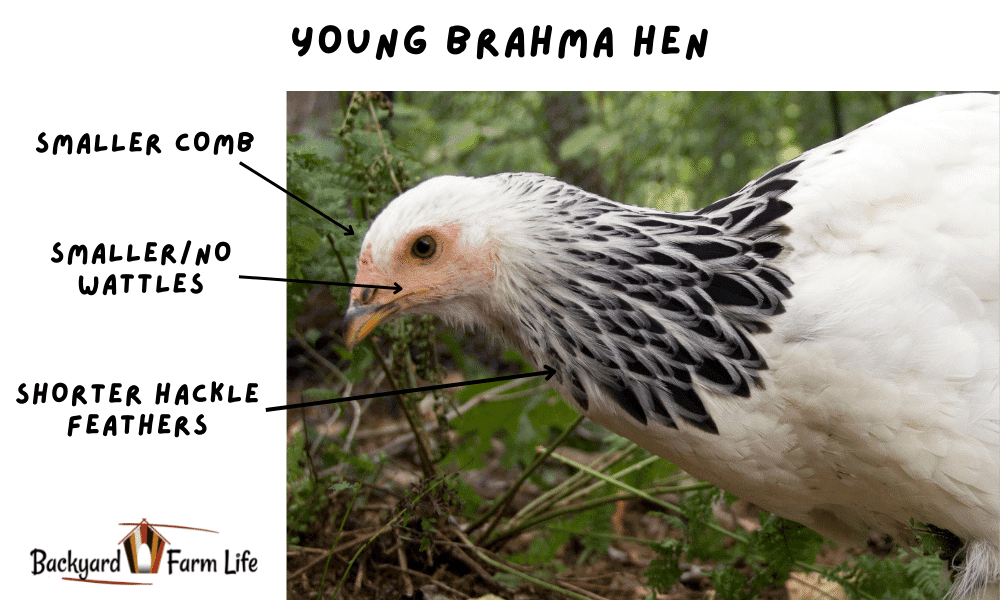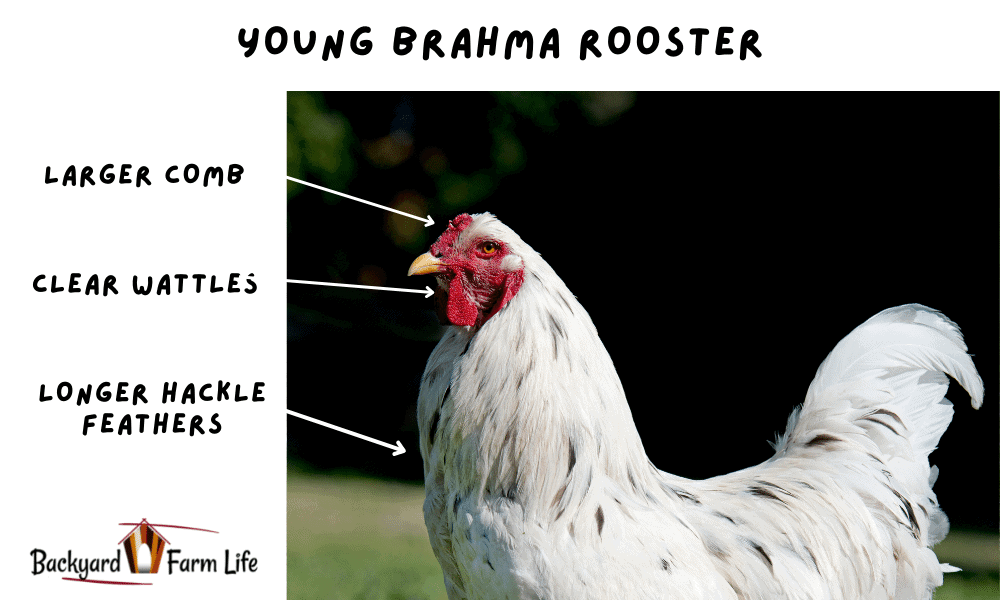These great beasts. Majestic. Fluffy. Beasts.
Yes, we’re talking about Brahma chickens.
Sure, it may be easy to tell the difference between a Brahma rooster and a hen in adulthood. After all, the sheer size difference and prowess of the rooster’s features make them stand out from the hens.
But, as young chicks and at all ages before maturity, it can be a little more challenging to work out if you’ve got male or female Brahma chickens.
To help you identify your chicks and chickens, here are all the characteristics of Brahma roosters and Brahma hens, and how you can tell the males from the females at all ages of their life.
Brahma Roosters And Hens: Characteristics


In my experience as a chicken owner, the first step to identifying male and female chicks from one another is to first look at what features and characteristics are prominent in adulthood.
This way, you can work backward and look for signs of these physical traits as your chicks develop.
So, to begin, here are all the main characteristics of Brahma roosters and Brahma hens.
Size
Brahma chickens are known to be one of the larger breeds of chickens out there, some growing up to 30 inches tall. They are considered one of the heavier breeds, and so they can’t fly very high at all!
Even though both Brahma roosters and hens are larger than standard chicken breeds, they still show a clear size difference between the two sexes.
Brahma roosters will generally grow up to about 22-24 inches tall and weigh 12-14 pounds, whereas Brahma hens will grow up to about 18 inches tall, weighing between 8-10 pounds.
This size difference between male and female Brahma chickens will start to show from anywhere as early as 10 weeks old, but it isn’t always obvious.
Wattles & Combs
Wattles and combs are characteristics that all chicken breeds have, some in more traditional senses than others though.
Some breeds of chickens have both roosters and hens that grow significant combs and wattles, like Leghorns, Wyandottes, and Rhode Island Reds. Some other breeds show much clearer wattle and comb differences, like Silkie roosters vs. hens, or Polish roosters vs. hens, or even Delaware hens and roosters.
Although both Brahma males and females grow combs and wattles, these features are much more prominent in Brahma roosters, and develop from a much earlier age than Brahma hens!
This is one of the key differences to look out for from about 6-12 weeks of age.
Hackle & Tail Feathers
Amongst many chicken breeds, a distinctive trait that roosters show over their hen counterparts is the prominent growth of hackle and tail feathers. Take Easter Egger roosters vs hens or Ameraucana roosters vs hens for example.
Just the same way, a Brahma rooster at maturity will have much longer hackle feathers that grow in layers around their necks down to their chests. Brahma roosters will also appear to have much longer and fluffier tail feathers too.
Brahma hens will still have these same hackle feathers, but they will be much neater, shorter, and pointer.
Color
Though Brahma roosters usually have a black base and Brahma hens have a gray base, color isn’t really a differentiating factor between hens and roosters.
Still, both can come in three primary colors:
- Light: white base color with splotches of white and black with a black tail.
- Buff: gold base with white and black spots and a black tail.
- Dark: gray or black base color with white-colored wings and feathers.
Behavior
While roosters are by nature a bit more territorial or aggressive than hens, all Brahma chickens, even roosters, are known to be peaceful and friendly.
In terms of gender-specific behaviors, Brahma hens will begin to lay eggs from about 7 months old, whereas Brahma roosters will begin crowing from about 16-24 weeks old.
If you still haven’t worked out if you’ve got a male or female based on appearance, the laying of eggs or regularly crowing will certainly give it away!
Is My Brahma Chicken Male Or Female?

So, the main differentiating characteristics between a male and female Brahma chicken are their overall size, prominence of wattles and combs, and size of their hackle and tail feathers.
As Brahma chicks grow and develop, these traits begin to show at different ages, which can help you identify which are males and which are females!
0-4 Weeks Old
Unless you’re an expert at vent examinations, from 0-4 weeks old young baby Brahma chicks have little to no differentiating traits between the males and females.
They all look like little buff or light brown fluff balls. There will be little to no difference in size, and they will all still have their baby feathers.
At this age, you can still make bets and guesses based on your instincts!
4-8 Weeks Old
From as early as 4 weeks old, you may start to see traits emerging that would suggest your chicks are either male or female.
This is because from as young as 6 weeks old, male chicks can start to show little pea-sized combs on their heads, and signs of wattle growth too.
Although they are small, the initial signs of wattle and comb growth are a key factor to watch for. This is because their presence at this young age normally means they are males, and females don’t begin to show wattle and comb growth until about 10-12 weeks old at the earliest.
8-12 Weeks Old
From about 8-12 weeks old there are quite a few factors you can use to narrow down your suspicions into educated guesses.
- Males can appear slightly larger than females.
- Males will develop longer hackle feathers.
- Wattles and combs will be much clearer and larger on males, and still may be non-existent on females.
18+ Weeks Old
From 18 weeks old your Brahma chickens will be considered mature. At this age you should see all the normal adult traits of your chickens, so from 18 weeks, it’s much easier to tell the roos from the hens!
However, wattles and comb growth will continue well into adulthood, and roosters will continue growing in size too.
A Quick Summary
So there you have it.
These wondrously loving chooks have some pretty clear physical differences between the hens and roosters.
Granted, not all of these physical traits can be observed from so early on in their development.
Still, you should be able to make some educated guesses from age 4-8 weeks based on wattle and comb development of roos.
By 12 weeks you should be in a position to make a pretty certain guess, as wattle, comb, and hackle & tail feather development will be evident.
If you’re still having trouble, feel free to comment or reach out via our Facebook Page. We would love to take a look and share our thoughts!
